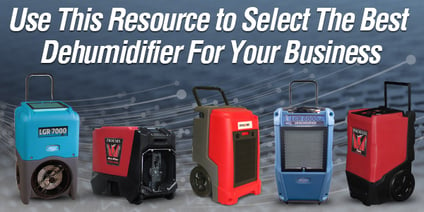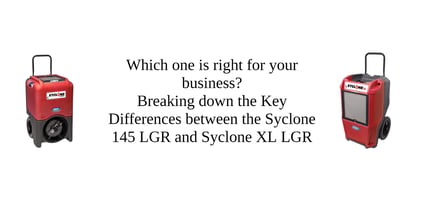Post 2 of 2 in our Dehumidifier Series
In our first dehumidifier post, we talked about the most important factors that you want to consider when buying a dehumidifier.
Once you have bought your new dehumidifier, the results that you get from it largely depend on how well you use it.
Even if you have the fanciest dehumidifier that is an absolute machine, you will waste time and money if you aren’t operating it correctly. Drying will take longer, or worse, you could end up having to redo a job.
You want to do everything you can to avoid this.
This blog post is going to teach you about the most common mistakes that contractors make when using dehumidifiers.

These are the Most Common Mistakes That You Want to Avoid When Using a Dehumidifier
1. Using the dehumidifier outside of the correct operating temperature (this is way more common than you think!).
“A lot of low-grain refrigerants (LGRS) work at an optimal temperature range. A lot of times contractors go in and stick them into a job, and once the equipment has been operating for 24 to 48 hours, the temperatures start rising," Rachel Adams, a consensus body member for the IICRC standards and restoration expert explains.
"The dehumidifiers will go outside of that temperature range. Dehumidifiers stop operating efficiently at 85 to 95 degrees Fahrenheit. Contractors forget that they still need to control the temperature range of the room.”
The most practical thing to do to avoid this happening is to read the manual to confirm the operating range of the unit that you are working with. You should be taking daily readings and adjusting the environment accordingly to make sure that you are drying effectively and that your equipment is operating within the range that the manufacturer has specified.
2. Not taking correct readings daily
“You have to take a correct reading of the materials that you are drying with your meter and interpret what the data is telling you. If you’re not getting good grain depression then you have to look at why; it could be that it’s outside of the temperature range, or that it’s in defrost mode,” Adams says.
If you are not taking correct daily readings you have no way of knowing how close you are to your dry standard.
This means that your equipment could be turned on but it’s not performing how it should be, leading to wasted time, energy, and money.
3. Eyeballing the room to determine how much equipment is needed instead of doing the necessary calculations required
“Sometimes people rely too much on their experience. They go in and put equipment in and don't really do the math needed to calculate or size the job correctly based on what kind of dehumidifier they have. All dehumidifiers are rated by Aham at 80/60, so you should factor rates based on how many pints of water you can remove in 24 hours,” Adams says.
Rather than using that mathematical formula to determine how many units you need on day one, a lot of times contractors don’t do it. They just throw equipment at a job without knowing if it’s the right amount.”
Fortunately, most companies have apps that support doing the necessary calculations. If you aren’t using one of the apps that are available from companies like Phoenix, you should download them.
“When using the apps you plug in the temperature and relative humidity and it will do the calculations for you,” Adams says.
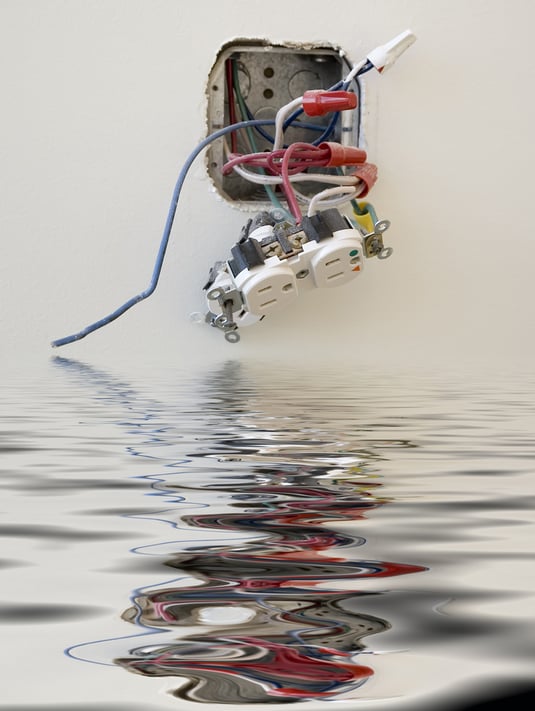
4. Drying materials that you are unfamiliar with drying
In the last post, we talked about how the purpose of a dehumidifier is to remove moisture from the surrounding environment.
Your ability to dry a room changes depending on what type of materials you are working with because some materials are harder to dry than others.
For example, concrete doesn’t like to easily give up water, so more heat and equipment may need to be added to it in addition to the dehumidifiers that you are using.
“You want to use equipment that can apply the appropriate amount of heat to surfaces,” Adams summarizes.
“The S500 has an entire chapter on drying for different materials that contain a chart for every type of building material imaginable”
On a similar note, different states have different drying standards for all materials. You have to set a standard for every house that you are drying.
“It's essential to get a base range for the moisture content in an area of the house that isn’t affected so that you have an idea of where you want to dry to,” Gabe VanDusseldorp a Regional Sales Manager for Aramsco that has decades of experience in the Restoration Industry, explains.
“There are so many different types of flooring besides wood and carpet,” he advises.
“Luxury Vinyl Tile (LVT) is on the rise. If you don’t check for water beneath the tile, you can actually be stuck with water that is left underneath it.
You want to thoroughly inspect the material that you are working with. If contractors just go in and aren’t diligent they can leave a thin layer of water on the floor and think that everything is dry.
When this happens you could end up having secondary damage such as mold growth or failure of the flooring system.”
5. Not standardizing equipment for repairs, maintenance, and training.
In the first post of this series, we talked about how to standardize your dehumidifiers to make them more user-friendly.
If you’re out in the field and have a unit that needs a replacement filter, you don’t want to waste your precious time on maintenance.
Your technicians will have a much easier time taking care of dehumidifiers and making them run smoothly if all of your equipment is a similar make and model.
By standardizing your equipment, everyone that works for you will know how to use the equipment regardless of what job they are working on.
In the worst-case scenario, if your dehumidifier breaks down on you, you will have an easier time contacting the customer support number to get help over the phone.
When you show up to take care of a customer's house, the way that you present yourself plays an outsized role in how you are perceived. There is a high likelihood that your customer just experienced their first flood and they are dealing with a traumatic and uncertain situation.
If you have equipment that is dented, in poor shape, or with a full filter your customers are going to question whether you are the right professional to take care of their home.
It’s easy to overlook proper care of your equipment as you go throughout your daily work. To avoid leaving a negative impression remember to keep your customer’s perspective in mind and take care of your dehumidifier after every job. They aren't familiar with the equipment, but they know what something clean should look like.
Make sure that your dehumidifier isn’t noisy and that it’s always cleaned and well-maintained.
“Maintenance of your equipment is the only other part of your company that people see besides you. You can have the prettiest smile and be the most charismatic person in the world, but if your equipment is dirty or doesn’t run right, your customer doesn't care how nice you are,” VanDusseldorp recounts, citing years of personal experience running a restoration company.
“The homeowner will look at the equipment and think ‘this guy doesn’t take care of his equipment; how is he going to take care of my house?”
Proper maintenance of your equipment doesn’t have to take a lot of time but it will have a large impact on your company’s performance and reputation.

7. Not purging your dehumidifier at the end of every job
You never want to unplug your dehumidifier and just load it onto your truck.
Unfortunately, most people that are in a hurry do this and end up negatively impacting their business.
So what should you do at the end of a job?
“What contractors should be doing at the end of every job is going to the piece of equipment, making sure that it’s still on, and hitting the purge button at least two or three times," VanDusseldorp emphasizes.
“The reason for this is that there is a reservoir at the bottom of the dehumidifier with a purge system. This purges the reservoir of the water.”
Most dehumidifiers have a timer built into them. Dehumidifiers will purge water every x amount of minutes, but they will not drain the water if the timer doesn’t run all the way to zero.
If you arrive at your next job site and the water level is full, the timer will restart and the water will run over.To prevent this from happening, you will need to purge the dehumidifier manually.
“In order to do this, go to your machine and locate the purge button. You hit purge and manually bypass the timer. This will shove all of the water out. It won’t only prevent overflow, but it will also prevent the machine freezing if you’re in the Midwest or another cold area,” VanDusseldorp explains.
“Doing this will prevent you from having to take care of a 700-dollar repair bill in cold areas,” he adds.
The consequences of forgetting to purge your equipment don’t just end there.
If you have standing water microbial growth can also occur. It could cause your dehumidifier to stink, and all of the air coming out of the dehumidifier that leaves the machine can contaminate the next job site.
VanDusseldorp summed it up well. “My big thing is you’ve spent anywhere between 1200 to 3000 dollars on this piece of equipment, it’s important to know how to pack it up. It’s a huge red flag when contractors just show up to their job site and after everything is dry they just start unplugging equipment and wrapping it up.”
Conclusion
We want you to be successful at every job that involves water damage.
There is a lot that can go wrong when you use a dehumidifier, but if you avoid the mistakes discussed above you will be able to respond efficiently to water damage, achieve an optimal dry time, and avoid making costly mistakes.
Any contractor that follows this advice will make significant progress towards running a successful restoration business.
Enjoyed reading this post? Read the following articles:
Featured Products
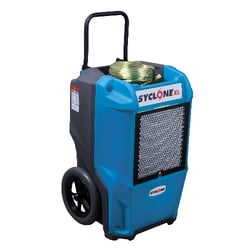
Syclone, Dehumidifier with Filter, XL LGR, Blue
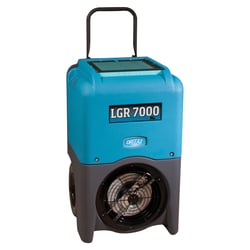
Dri-Eaz, Dehumidifier, LGR 7000 XLi
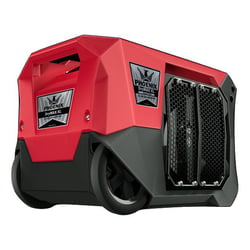
Phoenix, Dehumidifier, DryMax XL LGR, Red

